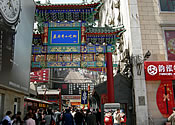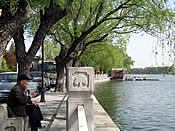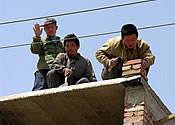A BEIJING TOUR |
|
Tiananmen Square
Built in 1417 during the Ming Dynasty, Tiananmen Square is the large plaza near the center of Beijing, named after the Tiananmen (Gate of Heavenly Peace) that sits to its north. Enlarged in 1949, the square totals 440,000 square meters. It is the largest open urban square in the world..
Tiananmen Square has been the site of various political events, such as the proclamation of the People's Republic of China by Mao Zedong on October 1, 1949, and mass rallies during the Cultural Revolution. In 1989,it was the stage for the pro-democracy demonstrations that drew world attention. Seven days a week, the colored matching hats of Chinese tour groups and souvenir red flags stretch as faras the eye can see.
|
|
 |
Wangfujing Street
Wangfujing is one of Beijing’s most famous shopping areas. Much of the street is off-limits to cars and other motor vehicles. On busy days, people fill the entire road. Since the middle of the Ming Dynasty (16th century), Wangfujing has been a commercial center.
Some of Beijing’s oldest stores can be found here, along with its newest. The Wuyutai Tea Shop (est. 1887) stands a few doors down from the gleaming, five-story Wangfujing Bookstore. An elegant century-old restaurant serving Peking Duck lies around the corner from the world’s largest Kentucky Fried Chicken. An open-air market, with stalls selling everything from candied apples on sticks to ceramic Buddhas, does a brisk business.
|
|
 |
Houhai Lake
For years, this leafy lakeside neighborhood north of Tiananmen Square attracted only park visitors, weekend fishermen, bathers, and pet owners walking their dogs and birds. Houhai and the two lakes next to it were dug out in the Yuan Dynasty (14th century) so that barges could bring goods from around China and beyond to the Emperor in his nearby Forbidden City.
Today, Houhai has become a symbol of the "new" China. Stylish bars and popular restaurants now crowd the lakeside, giving it two personalities. In the daytime, it continues to draw park visitors of all ages, along with tourists. At night, it attracts the young and hip to its trendy establishments.
|
|
 |
Migrant Neighborhood
Along with shiny new buildings, China’s economic boom has also brought new neighborhoods where migrants from rural parts of the country live in back streets and alleys. The main streets of these neighborhoods are full of activity. Small shops offer household goods and street-side vendors sell pet fish.
Construction and dirt piles slow down traffic. You can make a meal of steamed dumplings, skewered meat, and snack cakes, all cooked on the spot.
The neighborhood photographed here lies in Beijing's Fengtai district. It could be anywhere in the city. Its residents are mostly migrant workers and day laborers. Few are well educated. Official estimates put China’s migrant population at 120 million.
|
|
|